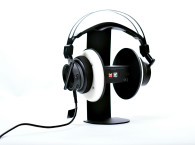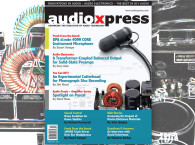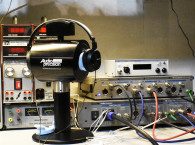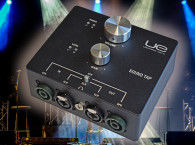
The TDOEs remind me a bit of that old joke about the Holy Roman Empire — it was neither holy, Roman, nor an empire. In this case, the headphones really aren’t “over ears.” They’re more of an on-ears/over-ears hybrid. The earpads are small enough not to engulf the pinnae entirely, but large enough to form something of a seal around the perimeters of the pinnae. Likewise, there are only two drivers — the third isn’t actually a driver since there’s no electrical signal presented to it. Instead, it is what 1MORE calls a bass reflector (and isn’t actually a reflector). More about that shortly.
Company Background
A little background on the company: 1MORE was founded by former executives at Foxconn, the Chinese electronics behemoth. Because of their experience with subcontracting design and assembly houses, they were able to leverage that knowledge to form a high-quality supply chain.
The result has been a line of headphone products that have been extremely successful in the Chinese domestic market, and now are experiencing a rapid expansion into other geographic areas. For North America, 1MORE has established a headquarters in San Diego, CA, and its marketing strategy appears to be relying on influencers and viral marketing, rather than the traditional heavy advertising campaigns.
1MORE heavily promotes the idea that its headphone designs are “tuned” by Luca Bignardi, an experienced MIDI programmer and mixing engineer. The description of the process is a bit vague and more analogy than substance, but whether the process is equalization or “floobydust,” this is certainly part of the marketing story needed for differentiation in a crowded market. You can read 1MORE’s take on it at the link provided in Resources.
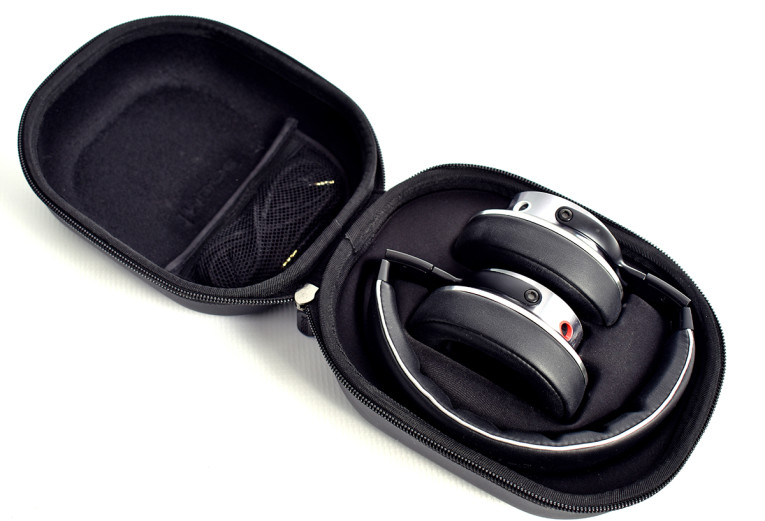
The Product
True to the marketing-driven approach, the packaging for the TDOEs is elaborate and has a luxurious feel. When the box is unfolded, the inner covers are decorated with vaguely da Vinci-ish sketches. Included in the package are a soft carrying bag and a hard-shell case for the headphones. The headphones fold up to fit in the case (see Photo 2), but the overall case size is a bit large for traveling, at least for placing in carry-on bags.
Also included is a cable terminated with a 3.5 mm TRS plug on one end and a Y-split cable at the other, with connections to the headphones made separately by left and right channel plugs that go to each earpiece. As with the packaging, the cables and plugs feel solid and very high-end. A helpful touch was easily visible color-coding of the left and right channel connectors (see Photo 3).

The headphones themselves feel far more solid and well-constructed than you’d expect at their price point. There’s very little plastic, with most of the construction being anodized aluminum and leather. The earcups pivot on two axes for fit and comfort, and there’s no discernable play — can I say “solid and luxurious” again? Despite the solid feel, the TDOEs are relatively light (about 10 oz or 300 g).
The headband and ear pads are extremely soft and compliant. One more nice touch for those of us aging Baby Boomers who usually need to squint to make out channel designations is that the inside of the earcups have very large printed R and L designators that are about the size of the leading E on an eye chart (see Photo 4).
Although physical comfort is even more subjective than sound quality, I have to say that unlike most headphones, I found the TDOEs to be extremely comfortable for my head and ears, and I was able to wear them for hours on end without fatigue or ear-sweat.

More controversial is the styling, which apparently was overseen by an automobile enthusiast. The outer part of the earcups have transparent polycarbonate covers to form a sound chamber with the so-called bass reflectors (which are visible through the polycarbonate), but the transparent covers have a molded plastic piece over them, which is designed to resemble the spokes of an automobile wheel (see Photo 5). As far as I can tell, this is a purely decorative feature that has no acoustical function, but it does provide a nice place for dirt to settle. Compared to the functional aspects of the mechanical design, this styling gimmick is a minor annoyance. However, if you’re a gearhead, you might find it attractive. In any case, although the spoked feature gives the headphones the appearance of being open-backed, they actually are not, thanks to the polycarbonate covers.
One thing to note — the TDOEs are intended for music listening. They do not include a microphone or remote volume controls. This will be no surprise to serious headphone users, but I have noted complaints about this lack from various online reviews. An exploded view of the TDOE’s construction is shown in Figure 1.
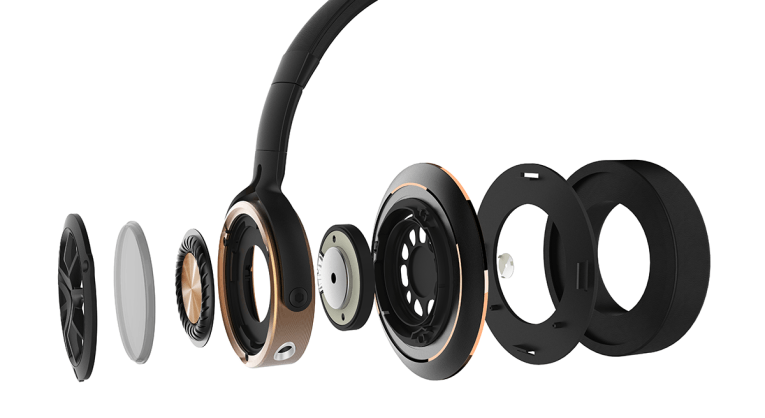
The heart of these headphones is a 40 mm diameter driver with a diaphragm made from polyester that has been vapor-coated with a layer of graphene, then thermoformed. The graphene, which is a two-dimensional crystal form of carbon, is intended to stiffen the diaphragm with a minimal increase in moving mass. 1MORE does not disclose the thickness of the coating, nor any supporting data to show that the graphene has a significant (or unique) effect. Nonetheless, its marketing heavily promotes the use of graphene in these drivers.
There are rumors on various websites that 1MORE makes a version of the TDOE using a titanium layer instead of the graphene for the European market. If true, I’d love to see the comparative performance. It’s unfortunate that “graphene” has been a major buzzword in tech products, replacing the last fashion, “nano.” And that’s why I’m curious and a bit frustrated at 1MORE for not being forthcoming. If the use of a graphene coating is a real technological plus rather than a marketing gimmick, I’d think the company would be eager to show data demonstrating the superiority of the approach.
At the high-frequency end, the main driver crosses over to a ceramic piezoelectric driver. 1MORE would not provide any information on the crossover point or the slopes. In Internet searching, I’ve seen a variety of confident answers to this, no two of which are the same. In any case, because I was reluctant to take the headphones apart to check this for myself, like the actual effects of the graphene coating, it will remain a mystery for the moment.
At the low-frequency end, 1MORE touts its “Bass Reflector,” which strikes me (again) as a marketing term rather than technical. Of course, as I previously mentioned, it is in no way a driver since it’s a passive element. Given the dimensions of headphones and the drivers relative to the wavelengths of bass sounds, “reflector” is also an inapt term. When I asked about the Bass Reflector’s function, 1MORE refused to comment beyond some vague marketing-speak (I’m sensing a pattern here!). But with a bit of examination, I think we can reasonably hypothesize.
The Bass Reflector looks like a passive radiator, with a flat rigid diaphragm surrounded by a compliant elastomer suspension. This forms an enclosed acoustical cavity between the Bass Reflector and the polycarbonate covers, this volume being behind the main 40 mm driver. This cavity will have a resonance, which depends on the cavity volume and compliance, the mass of the diaphragm, and the compliance of the suspension. So the back of the 40 mm driver is loaded by this resonator, which may serve to increase the effective rear volume and enhance the bass output below the 40 mm driver’s normal resonance. The potential downside to this is that the asymmetrical load between the front and the back of the 40 mm driver might be expected to exhibit increased second-order harmonic distortion.

Performance
Let’s get to the crux of the muffin. I performed several sets of measurements using an Audio Precision APx525 audio analyzer, the APx1701 transducer interface, and the AECM206 headphone test fixture (see Resources). A few measurements were repeated using the miniDSP EARS headphone test fixture (reviewed in the March 2019 audioXpress issue) in conjunction with the APx525. Listening at home, work, and a hotel was mostly done using a CEntrance DACportable DAC/headphone amplifier. My listening while hiking used a decidedly lower tech iPhone 8 with a standard Lightning-to-3.5 mm adapter module.
Figure 2 shows the TDOE’s impedance magnitude and phase versus frequency. 1MORE rates the impedance at 32 Ω, which seems very reasonable. Note that the magnitude curve is relatively flat, and that the phase angle stays below ±10°, which is a very easy load to drive with just about any headphone amp. The sensitivity was likewise high, with 63 mV (0.12 mW) yielding a sound pressure level of 95 dB at 1 kHz. My iPhone, not exactly a powerhouse, had no difficulty driving the TDOE cleanly to much higher levels than I am comfortable.
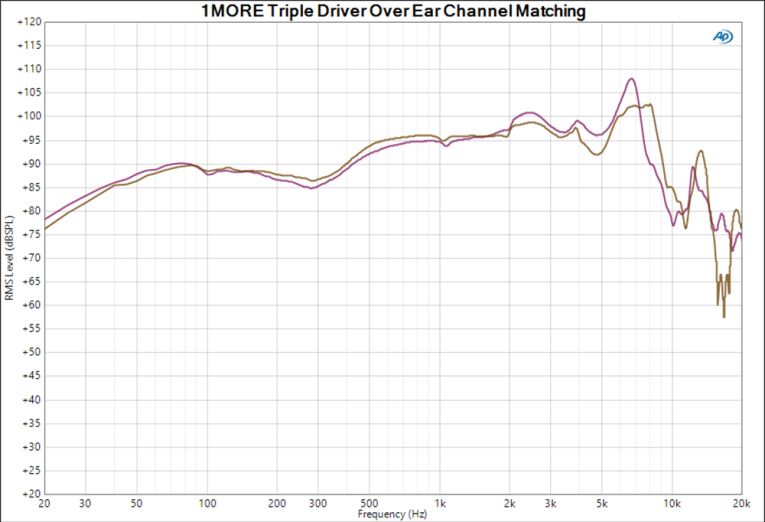

Figure 3 and Figure 4 show the frequency response measured with the AECM206 and miniDSP EARS test fixtures, respectively, with the former also showing the matching between channels. I’m presenting results from both setups because test fixtures do show significant variations in their measurements due to different dimensions, different sizes and hardnesses of the artificial pinnae, and different artificial ear canal geometries. So with both of these plots, we can look at the commonalities and attribute those to the actual performance of the headphones.
The most interesting feature is the shelf in the bass response. This is totally unexpected because subjectively, the TDOEs have bass that is... not shy. Not boomy or overripe, but not at all reticent and a bit tipped up. The texture and definition of the bass also struck me as very good, if not the very best I’ve heard. One example that stood out to me in subjective listening was the Steven Wilson remix and remaster of the classic Jethro Tull album Benefit.
The kick drum and bass stood out individually with no hint of muddiness or boom. It really gave me a sense of the improvement with this album edition. What could explain the disconnect between measurements and perception? I will venture that the root cause is the seal of the headphones to the artificial ears.
I mentioned in my reviews of both test fixtures that the pinnae do not bend and compress in the same way as actual human ears, and this is clearly going to be critical with the sort of hybrid over-ear/on-ear seal that the TDOEs depend on to achieve their good bass response. To test this hypothesis, I measured the TDOEs on the miniDSP EARS fixture, then remeasured with a rubber band put around the headphones and fixture to artificially compress the earpads and increase the seal. The results are shown in Figure 5 and the 10 dB boost in that bass shelf clearly demonstrates that the issue is the fit to the test fixtures, not with the response of the TDOEs themselves.
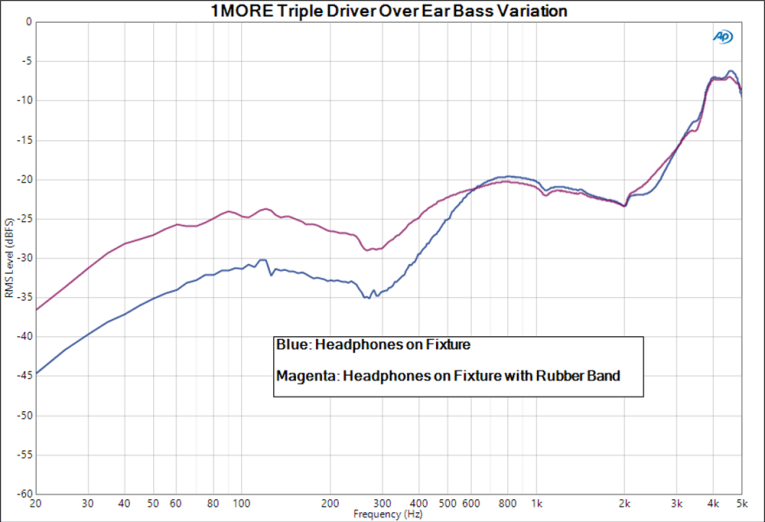
What does correlate with my subjective perceptions is the deep notch at about 10 kHz. It doesn’t make the TDOEs sound dull, but it does serve to take the edges off recordings and gives a sound that is easy and non-fatiguing to listen to without at all sacrificing clarity or definition — which these headphones have in spades. Ditto the slight unevenness in the midrange. This does not come across as a recessed or muffled tonality, but more of a relaxed and easy quality. Close-miked and compressed vocals in particular can be annoying (and are more often than not the norm in commercial recordings), but the TDOEs tended to smooth them over. A good example is "Matt the Electrician Is Alive," which can be almost unlistenable with a lot of headphones and speakers, but had its ear-laser quality noticeably reined in with the TDOEs.
Another subjective perception was that of the suppression of external noise. There’s no active noise cancellation, but slipping the TDOEs on immediately made things around me significantly quieter. In this sense, the passive noise-blocking of the TDOEs was much more like over-ear than on-ear headphones, and the very soft and compliant earpads worked as intended. Figure 6 shows the passive noise reduction achieved by the TDOEs. This measurement was taken by placing the AECM206 headphone test fixture about a meter from a pink noise source and measuring the response with and without the headphones in place. The response with the headphones was then ratioed to the noise with the bare test fixture to eliminate the influence of any response variations in the source. As can be seen, the effectiveness increases significantly in the critical midrange and treble, and 25 to 35 dB of passive noise reduction is achieved in the regions where hearing is most sensitive.

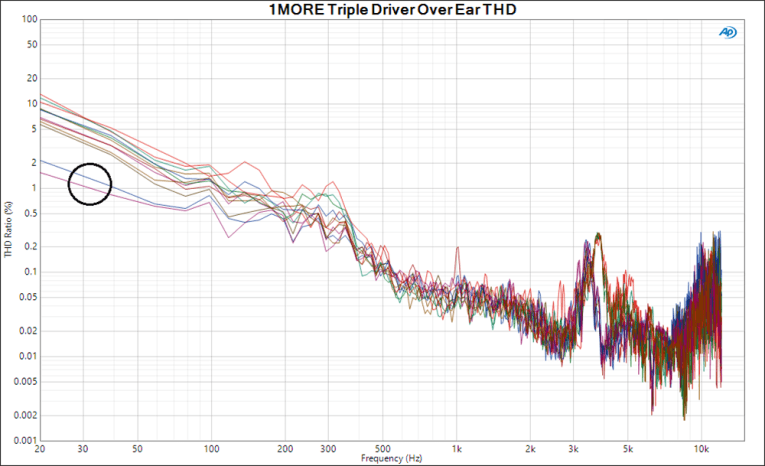
Another Observation
I like to listen to music when I’m out walking or hiking. Unfortunately, living in the Chicago, IL, area, the experience is often marred by excessive noise from the ever-present wind. My usual over-ear headphones, which normally do a decent job of acoustic isolation, become almost useless, seemingly amplifying the wind noise. The 1MORE TDOEs did a terrific job of reducing that noise to nearly unnoticeable levels. Impressive indeed, and since they arrived, my old headphones have been relegated to indoor use only.
Distortion performance is shown in Figure 7, which was taken with the AECM206 fixture and at 90 dB level at 1 kHz. Each curve is a single measurement after repositioning. Because of the seal issue mentioned previously, the rise in distortion in the bass is likely an artifact of the test, and indeed, when I lightly squeezed the headphone cups to the test fixture with my hands, the bottom two curves (indicated by a circle) were generated, showing dramatically lower bass distortion.
An interesting feature of the distortion curve is the spike in distortion to 0.2 to 0.3% between 3 and 4 kHz, with a slightly different peak frequency and amplitude between left and right channels. To make sure that this curious feature was due to the headphones and not the measurement, I repeated it with the miniDSP EARS and using REW software. The same feature was present, and harmonic analysis showed that it is principally second order. It’s likely not a coincidence that it coincides with the small impedance peak seen in Figure 2, so there’s more than a good chance that this is either a diaphragm resonance or a hint about crossover point. Since piezo tweeters are rarely crossed over that low, and there’s some inconsistency between channels, my bet would be on the former. I can speculate that whatever causes this resonance may well be responsible for the rather smooth and relaxing midrange.

Wrap-Up
I admit that I’m not particularly a headphone enthusiast. I’ve gotten to spend time with a lot of different high-end models, but I’m a loudspeaker enthusiast first. Most of my headphone use is either when I’m traveling, during hikes, and occasionally for mastering my recordings. Although I’m certainly aware that the sound I got from the TDOEs doesn’t have the neutrality or ultimate definition of the best headphones I’ve used, and is a bit too colored for mastering use, I found myself using these headphones for listening for enjoyment much more so than any of the other headphones that have passed through here.
For dedicated headphone geeks, the TDOEs might not be their first choice, but for someone more interested in headphones that are easy to drive, easy to wear, and easy to listen to, they’re a great deal at the $250 asking (and under-$200 street) price. My only real regret is that the interesting technology and careful engineering that undoubtedly went into achieving these goals is overwhelmed by the marketing, but I can’t fault the company for recognizing that its target market is broader than techno-nerds like me. aX
This article was originally published in audioXpress, February 2019.
Resources
1MORE Triple Diver Over Ear headphones
https://usa.1more.com/collections/headphones/products/tripleoverear
https://usa.1more.com/blogs/reviews/a-little-light-on-luca-bignardi-and-tuning
O. Masciarotte and S. Yaniger, “CEntrance DACportable High-Resolution USB DAC and Headphone Amplifier,” audioXpress, April 2017, https://www.audioxpress.com/article/fresh-from-the-bench-centrancedacportable-high-resolution-usb-dac-and-headphone-amplifier.
S. Yaniger, “Audio Precision AECM206 Headphone Test Fixture,” audioXpress, April 2018.
https://www.audioxpress.com/article/fresh-from-the-bench-audio-precision-aecm206-headphone-test-fixture




